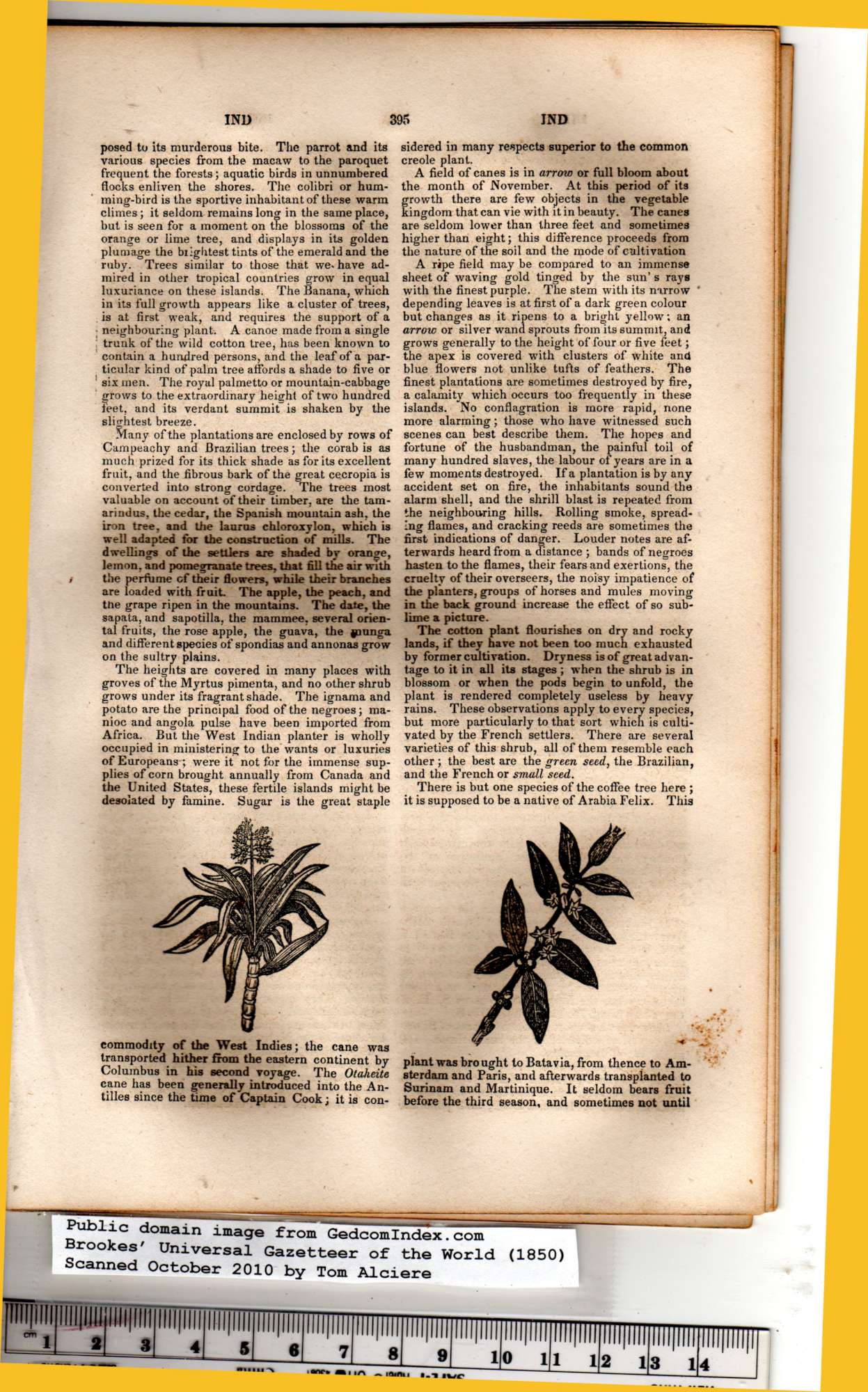|
posed to its murderous bite. The parrot and its
various species from the macaw to the paroquet
frequent the forests; aquatic birds in unnumbered
flocks enliven the shores. The colibri or hum-
ming-bird is the sportive inhabitant of these warm
climes; it seldom remains long in the same place,
but is seen for a moment on the blossoms of the
orange or lime tree, and displays in its golden
plumage the brightest tints of the emerald and the
ruby. Trees similar to those that we. have ad-
mired in other tropical countries grow in equal
luxuriance on these islands. The Banana, which
in its full growth appears like a cluster of trees,
is at first weak, and requires the support of a
xe2x80xa2 neighbouring plant. A canoe made from a single
1 trunk of the wild cotton tree, has been known to
contain a hundred persons, and the leaf of a par-
ticular kind of palm tree affords a shade to five or
! six men. The royal palmetto or mountain-cabbage
grows to the extraordinary height of two hundred
feet, and its verdant summit is shaken by the
slightest breeze.
Many of the plantations are enclosed by rows of
Campeachy and Brazilian trees; the corab is as
much prized for its thick shade as for its excellent
fruit, and the fibrous bark of the great ce.cropia is
converted into strong cordage. The trees most
valuable on account of their timber, are the tam-
arindus. the cedar, the Spanish mountain ash, the
iron tree, and the laurus chloroxylon, which is
well adapted for the construction of mills. The
dwelhngs of the settlers are shaded by orange,
lemon, and pomegranate trees, that fill the air with
the perfume of their flowers, while their branches
are loaded with fruit. The apple, the peach, and
tne grape ripen in the mountains. The date, the
sapata, and sapotilla, the mammee, several orien-
tal fruits, the rose apple, the guava, the jpunga
and different species of spondias and annonas grow
on the sultry plains.
The heights are covered in many places with
groves of the Myrtus pimenta, and no other shrub
grows under its fragrant shade. The ignama and
potato are the principal food of the negroes; ma-
nioc and angola pulse have been imported from
Africa. But the West Indian planter is wholly
occupied in ministering to the wants or luxuries
of Europeans ; were it not for the immense sup-
plies of corn brought annually from Canada and
the United States, these fertile islands might be
desolated by famine. Sugar is the great staple
commodity of the West Indies; the cane was
transported hither from the eastern continent by
Columbus in his second voyage. The Otaheite
cane has been generally introduced into the An-
tilles since the time of Captain Cook; it is con-
sidered in many respects superior to the common
creole plant. |
A field of canes is in arrow or full bloom about
the month of November. At this period of its
growth there are few objects in the vegetable
kingdom that can vie with it in beauty. The canes
are seldom lower than three feet and sometimes
higher than eight; this difference proceeds from
the nature of the soil and the mode of cultivation
A ripe field may be compared to an immense
sheet of waving gold tinged by the sun’s rays
with the finest purple. The stem with its narrow
depending leaves is at first of a dark green colour
but changes as it ripens to a bright yellow7; an
arrow or silver wand sprouts from its summit, and
grows generally to the height of four or five feet;
the apex is covered with clusters of white and
blue flowers not unlike tufts of feathers. The
finest plantations are sometimes destroyed by fire,
a calamity which occurs too frequently in these
islands. No conflagration is more rapid, none
more alarming; those who have witnessed such
scenes can best describe them. The hopes and
fortune of the husbandman, the painful toil of
many hundred slaves, the labour of years are in a
few moments destroyed. If a plantation is by any
accident set on fire, the inhabitants sound the
alarm shell, and the shrill blast is repeated from
the neighbouring hills. Rolling smoke, spread-
ing flames, and cracking reeds are sometimes the
first indications of danger. Louder notes are af-
terwards heard from a distance ; bands of negroes
hasten to the flames, their fears and exertions, the
cruelty of their overseers, the noisy impatience of
the planters, groups of horses and mules moving
in the back ground increase the effect of so sub-
lime a picture.
The cotton plant flourishes on dry and rocky
lands, if they have not been too much exhausted
by former cultivation. Dryness is of great advan-
tage to it in all its stages ; when the shrub is in
blossom or when the pods begin to unfold, the
plant is rendered completely useless by heavy
rains. These observations apply to every species,
but more particularly to that sort which is culti-
vated by the French settlers. There are several
varieties of this shrub, all of them resemble each
other ; the best are the green seed, the Brazilian,
and the French or small seed.
There is but one species of the coffee tree here ;
it is supposed to be a native of Arabia Felix. This
plant was brought to Batavia, from thence to Am-
sterdam and Paris, and afterwards transplanted to
Surinam and Martinique. It seldom bears fruit
before the third season, and sometimes not until |
